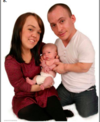Skeletal dysplasia Flashcards
Skeletal dysplasia
Category of disorders regarding abnormal bone and cartilage
General clinical features: short stature & limbs, macrocephaly, slow growth, bone deformities
Rhizomelia
Meso melia
Micromelia
Rhizomelia: short proximal segment
Mesomelia: short distal segment
Micromelia: both segments are short

5 ways to diagnose skeletal dysplasia
Medical history
family history (pedigree)
physical exam
radiograph
molecular analysis
How do you measure upper to lower body ratio? Is it high or low for people with skeletal dysplasia?
Upper body: top of head to pubic symphysis
Lower body: pubic symphysis to soles of feet
Higher ratio (upper body longer than lower body)
Arm span to height ratio in people with skeletal dysplasia
Disproportionately short arm span
What are the lethal common skeletal dysplasias?
Osteogenesis Imperfecta Type II
Achondrogenesis
Thanatophoric dysplasia
What are the nonlethal common skeletal dysplasias?
Achondropalsia
Hypochondroplasia
Osteogenesis Imperfecta Types I , III, IV
OI Type II
Mutation
Symptoms
AD mutation in the COL1A1 or COL1A2 gene
Fractures of varying ages/stages of healing present at birth*, minimal skull mineralization, platyspondyly (flat vertebral bodies), compression of long bones
Achondrogenesis
Can’t produce cartilage -> death by respiratory failure
Short limbs and ribs, short neck, flat vertebrae, underdeveloped bones
Thanatophoric dysplasia
AD mutation in FGFR3
Cloverleaf skull, bowed femur (telephone receiver femur), frontal bossing, midface hypoplasia, protruding eyeballs, micromelia, macrocephaly, narow thorax, brachydactyly (short fingers/toes), hypotonia (low muscle tone)
What 3 diseases are all AD mutations in the FGFR3 gene?
Thanatophoric dysplasia, Achondroplasia, Hypochondroplasia
Normal intelligence, life span, and reproduction, but
rhizomelia, macrocephaly, forntal bossing, and midface retrusion?

Achondropalsia - most common cause of disproportionate short stature
Intelluctual disability & epilepsy with
Short stature, disproportionately shor tlimbs, shor thands and feet, mild joint laxity, and macrocephaly
Hypochondroplasia
Cloverleaf skull, frontal bossing, midface hypoplasia, protruding eyeballs, bowed femur with
Micromelia, macrocephaly, narrow thorax, brachydactyly, hypotonia
Thanatophoric dysplasia
OI Types I, III, and IV, share fractures, dentinogenesis imperfecta (tooth probs), and hearing loss.
how do you differentiate between them?
Type I: least severe, non-deforming, blue sclerae
Type III: progressively deforming
Type IV: variable OI, deforming
Between 1, 2, 3, and 4, what’s the most severe to the least?
Most severe: 2 (lethal) > 3 > 4> 1
What disease is this?

Thanatophoric dysplasia
AD mutation in FGFR3 gene
What doesthe achondroplasia mutation in the FGFR3 gene do?
Gain of function mutation in the fibroblast growth factor receptor gene 3 –> suppresses chondrocyte proliferation/differentiation –> short limbs
Meclozine is a drug that inhibits suppressors of chondrocyte prolfieration. This would help with which dysplasia?
Achondroplasia
Normal head size/face, normal intelligence, hypermobile joints, bowed lower extremities
What is this?

Pseudoachondroplasia: AD mutation in COMP gene, with postnatal onset
A newborn male with short stature and dysmorphic features has macrocephaly with frontal bossing, shortening of arms and legs. What is the molecular basis of this case?

Gain of function mutation
Which is true about achondroplasia?
- Low reproductive fitness
- Narrowing of craniocervical junction is one of the complications
- Endochondral ossification is unaffected
- Increased risk of fractures
- Narrowing of craniocervical junction is one of the complications
What disease is this?

Achondroplasia: frontal bossing, short stature & limbs, high upper:lower body ratio, rhizomelia
What disease is this?

OI type I (nonlethal)




